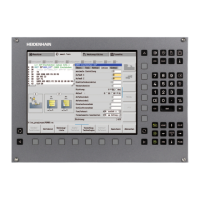January 2012 6.16 The Control Loop 891
Decelerating along
the braking ramp
The steepness of the emergency braking ramp (ramp for deceleration) is
defined in MP_motEmergencyStopRamp. The greater the value entered in
MP_motEmergencyStopRamp, the steeper the emergency braking ramp.
The maximum value for MP_motEmergencyStopRamp is limited by the
output power of the inverter. The minimum value is determined by
MP_maxAcceleration. The permissible acceleration of the axis during normal
machining operation is defined in MP_maxAcceleration.
The greatest possible value must be entered in
MP_motEmergencyStopRamp in order for deceleration to take place at the
limit of current.
Define MP_motEmergencyStopRamp (brake ramp in an emergency stop):
Use the value in MP_maxAcceleration as the minimum value
Use the emergency stop to brake the axis from rapid traverse, or the spindle
from high speed.
Increase the value entered in MP_motEmergencyStopRamp until the
braking time is as short as possible and the mechanics of the axis or spindle
are not overloaded.
If the brake ramp defined in MP_motEmergencyStopRamp has a smaller
gradient than the one defined in MP_maxAcceleration, the brake ramp
from MP_maxAcceleration is used for braking.
If you are switching from the iTNC 530:
With regard to deceleration at the limit of current, the iTNC 530 (MP2590)
differs from the MANUALplus 620:
iTNC 530:
If 0 is entered in MP2590, this leads to deceleration at the limit of current.
MANUALplus 620:
Entering the greatest possible value leads to deceleration at the limit of
current.
Entering 0 in MP_motEmergencyStopRamp on the MANUALplus 620
leads to a very flat braking ramp.

